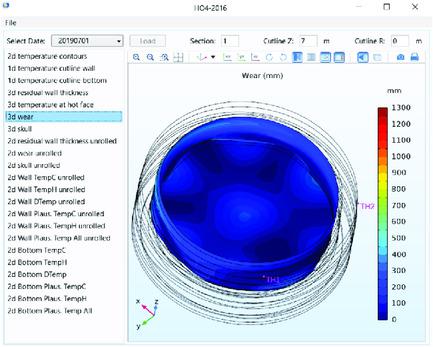当前位置:
X-MOL 学术
›
Steel Res. Int.
›
论文详情
Our official English website, www.x-mol.net, welcomes your
feedback! (Note: you will need to create a separate account there.)
Multiphysics Model of the Hearth Lining State
Steel Research International ( IF 1.9 ) Pub Date : 2020-06-17 , DOI: 10.1002/srin.202000055 Yalçın Kaymak 1 , Hauke Bartusch 1 , Thorsten Hauck 1 , Jörg Mernitz 2 , Harald Rausch 3 , Rongshan Lin 3
Steel Research International ( IF 1.9 ) Pub Date : 2020-06-17 , DOI: 10.1002/srin.202000055 Yalçın Kaymak 1 , Hauke Bartusch 1 , Thorsten Hauck 1 , Jörg Mernitz 2 , Harald Rausch 3 , Rongshan Lin 3
Affiliation

|
The campaign life of the blast furnace is governed by the erosion of the hearth lining. Therefore, it is essential to keep track of the residual lining thickness not only for the better planning of the relining but also for the operational safety to avoid dangerous hearth breakthrough incidences. Modern blast furnaces are equipped with many thermocouples in the hearth refractory to monitor the temperature level. Higher temperatures indicate a lower residual wall thickness. However, the measured temperatures are also influenced by many other effects such as thermocouple defects, brittle layers in the refractory, hearth cooling system, production rate, temperature, and flow state of hot metal. Existing models lack comprehensive checks of the data plausibility or of possible effects unrelated to wear. The new multiphysics approach provides a flexible platform to include these influences as well as other physical aspects that are important for operational hearth monitoring. For instance, thermal stresses and the deformation of the hearth lining and steel shell can be analyzed. This enables the integration of strain‐gauge measurements into the model which were recently suggested for the monitoring of liquid levels. The numerical computations and visualization are performed using COMSOL Server with MATLAB for the 3D hearth geometry. This enables the use of a standard web browser to visualize the results interactively on any device connected to the internal network without any local software installation. The developed multiphysics model is calibrated and validated by comparing the estimated wear profile with the measured residual wall thickness during the blast furnace relinings in 2016 at Eisenhüttenstadt and Dillingen. Two instances of the multiphysics model are online and in use for monitoring the hearth lining state at these plants.
中文翻译:

炉缸衬里状态的多物理场模型
高炉的运动寿命取决于炉膛衬里的侵蚀。因此,必须跟踪残留衬里的厚度,这不仅是为了更好地计划衬里,而且还为了避免危险的炉膛突破事故的操作安全。现代高炉在炉膛耐火材料中装有许多热电偶,以监控温度水平。较高的温度表示较低的残留壁厚。但是,测得的温度还受许多其他影响的影响,例如热电偶缺陷,耐火材料中的脆性层,炉膛冷却系统,生产率,温度以及铁水的流动状态。现有模型缺乏对数据合理性或与磨损无关的可能影响的全面检查。新的多物理场方法提供了一个灵活的平台,可以包括这些影响以及对操作炉膛监控非常重要的其他物理方面。例如,可以分析热应力以及炉衬和钢壳的变形。这样可以将应变计测量值集成到最近建议用于监控液位的模型中。数值计算和可视化使用COMSOL Server和MATLAB进行,用于3D炉膛几何形状。这样就可以使用标准的Web浏览器在连接到内部网络的任何设备上以交互方式可视化结果,而无需安装任何本地软件。通过将估计的磨损曲线与2016年在Eisenhüttenstadt和Dillingen的高炉衬砌过程中测得的残余壁厚进行比较,对开发的多物理场模型进行校准和验证。多物理场模型的两个实例在线并用于监视这些工厂的炉膛衬里状态。
更新日期:2020-06-17
中文翻译:

炉缸衬里状态的多物理场模型
高炉的运动寿命取决于炉膛衬里的侵蚀。因此,必须跟踪残留衬里的厚度,这不仅是为了更好地计划衬里,而且还为了避免危险的炉膛突破事故的操作安全。现代高炉在炉膛耐火材料中装有许多热电偶,以监控温度水平。较高的温度表示较低的残留壁厚。但是,测得的温度还受许多其他影响的影响,例如热电偶缺陷,耐火材料中的脆性层,炉膛冷却系统,生产率,温度以及铁水的流动状态。现有模型缺乏对数据合理性或与磨损无关的可能影响的全面检查。新的多物理场方法提供了一个灵活的平台,可以包括这些影响以及对操作炉膛监控非常重要的其他物理方面。例如,可以分析热应力以及炉衬和钢壳的变形。这样可以将应变计测量值集成到最近建议用于监控液位的模型中。数值计算和可视化使用COMSOL Server和MATLAB进行,用于3D炉膛几何形状。这样就可以使用标准的Web浏览器在连接到内部网络的任何设备上以交互方式可视化结果,而无需安装任何本地软件。通过将估计的磨损曲线与2016年在Eisenhüttenstadt和Dillingen的高炉衬砌过程中测得的残余壁厚进行比较,对开发的多物理场模型进行校准和验证。多物理场模型的两个实例在线并用于监视这些工厂的炉膛衬里状态。











































 京公网安备 11010802027423号
京公网安备 11010802027423号